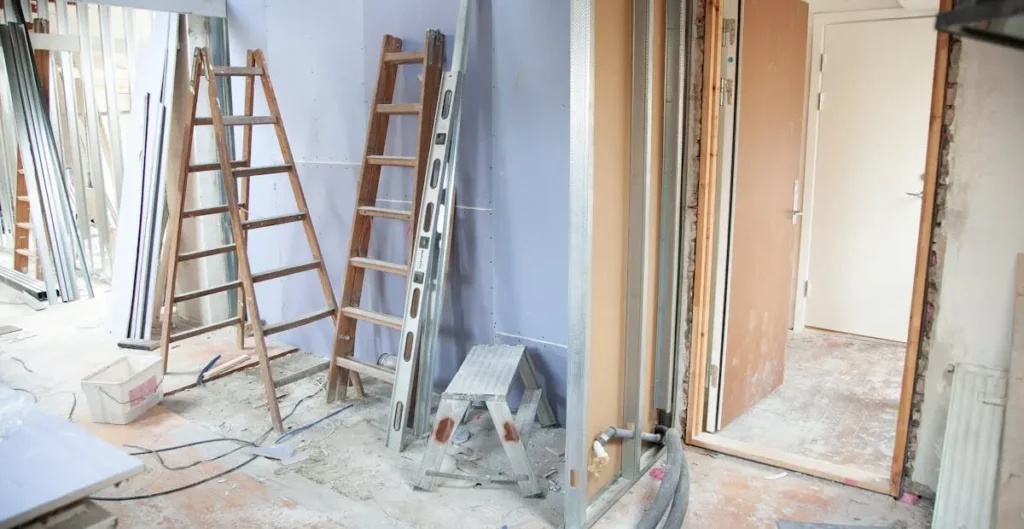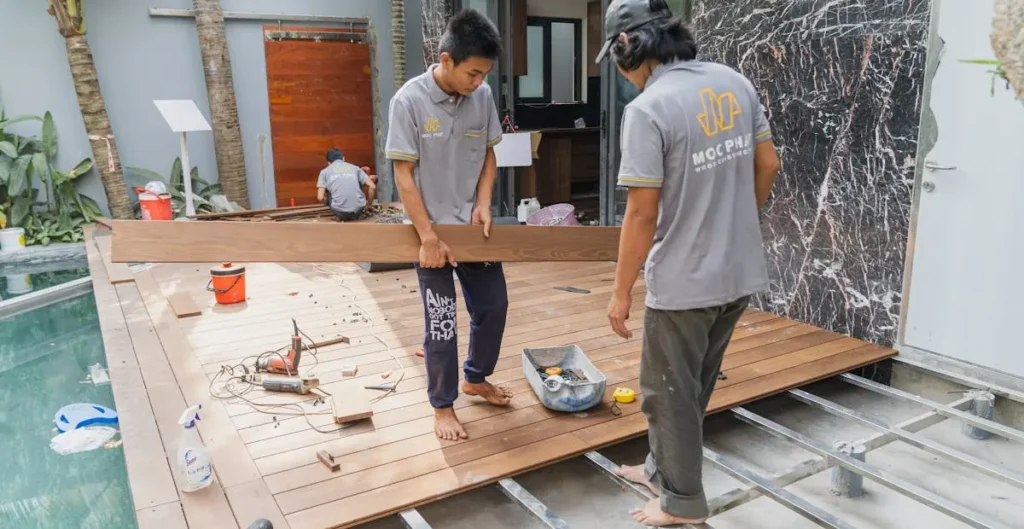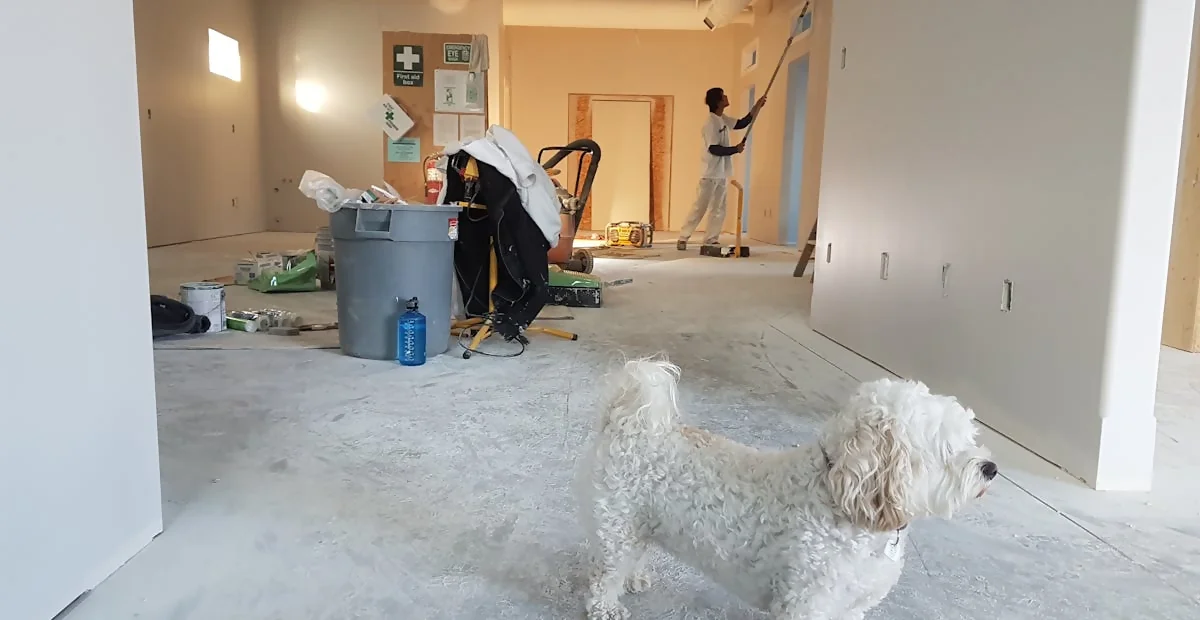Hey there! If you’re like me, you love giving your place a makeover but don’t want to deal with packing up and finding somewhere else to stay during the reno. I get it – moving is the worst, even temporarily. But here’s the thing: with some planning and creativity, you can remodel while living at home. I should know since I just finished a major kitchen redesign without leaving my house once! It wasn’t always easy, but these tips I’ve learned made the process doable. In this article, I’ll share how to keep your renovation rolling while still living your normal life in the middle of the chaos. Prepare for my best suggestions on scheduling contractors, setting up temporary kitchens and baths, containing dust and noise, and more. Let’s dive in!
The Challenges of Renovating While Living in Your Home

Limited Space
When you’re living in the middle of a renovation zone, space is limited. I had to clear half my basement to store materials and tools. Make sure you figure out storage solutions before the work begins.
Dust and Noise
The sounds of hammers and saws filled my home for weeks. And the dust – it got everywhere! Prepare to seal off work areas, wear masks, and vacuum constantly. Your patience may wear thin, but try to maintain your sanity by taking breaks from the chaos.
Disruption of Daily Life
simple things like cooking meals, doing laundry, and taking showers become challenging when parts of your home are torn up. I ended up living out of my bedroom and eating a lot of takeout. Be flexible and willing to improvise. The result will be worth it!
Cost Overruns
It’s easy for budgets to spiral out of control when unforeseen issues arise. Get multiple estimates, set a generous budget, and be ready for surprises. Take heart that the investment in your home will pay off down the road.
With patience, organization and the willingness to rough it for a while, you can survive renovating while living in your home. Stay focused on how great your updated space will be! The challenges will seem minor once you’re enjoying the finished product.
How to Plan Your Renovation Project While Living in Your House

Make a schedule
Having a well-thought-out schedule is key as someone currently living in a renovation zone. I created a master schedule that outlined each project, the steps involved, and time estimates for completion. This helped keep everything on track and avoided surprises.
Prioritize must-haves
Focus on any projects that will improve livability first. For me, fixing plumbing issues, upgrading electrical systems, and repairing the roof were at the top of my list. Cosmetic upgrades like new floors or a kitchen remodel came later.
Get necessary permits
Don’t forget to pull proper permits for major work. I found getting permits easier while I still lived in the house, so inspectors had full access. Permits ensure safety and protect you legally and when selling your home.
Move from room to room.
Instead of tackling the whole house at once, move from room to room or area to area. Complete one space before starting another. This approach reduces chaos and allows you to still live comfortably in the spaces not under renovation. With good planning, you can renovate your home while living there. Staying organized and focused on livability will make the process smooth sailing.
Tips for Managing Dust and Dirt During In-home Renovations
Seal off work areas.
Seal off the areas under construction from the rest of the house whenever possible. Use heavy-duty plastic sheeting and tape to create temporary barriers. This will help contain dust, debris, and fumes. Keeping renovations contained to one area or floor at a time made a big difference in managing the mess.
Ventilate and use air purifiers.
Run an exhaust fan to ventilate the work area and change filters in your HVAC system frequently. Air purifiers with HEPA filters can also help remove fine particles from the air in living spaces. I ran air purifiers on the highest setting during the day and at night to keep the air as clean as possible in our living rooms.
Cleanup constantly.
In addition to daily cleanup by the contractors, I did regular wipe-downs and sweeping in living areas to minimize tracked-in dust. A quick sweep or Swiffering in the entryway and a wipe-down of counters and surfaces a couple of times a day made a big difference. Mopping hard floors with a dusting pad or electrostatic mop was also helpful. Constant vigilance and cleaning on my part reduced the amount of grime that made its way into my living space.
Contains tools and materials.
Contractors must properly store tools, equipment, and materials when not in use to avoid tracking debris into living areas. A designated storage area or sealed container outside the home is best. Any tools or materials left lying around quickly become a source for dirt and dust to spread. Staying on top of containment from the beginning will make the renovation cleaner.
Creating Temporary Living Spaces During Renovations
When major renovations are underway in your home, having a comfortable place to escape the chaos is essential for your sanity. Set up temporary living spaces to give you refuge as the walls come down around you.
For me, the garage became my makeshift living room. I moved in a couch, TV, and coffee table to create a cozy space separate from the construction zone. It wasn’t glamorous, but it gave me a place to relax in the evenings without breathing in drywall dust. Consider making it into your temporary living space if you have an attic, basement or spare bedroom. Move furnishings, decor, lighting, electronics and anything else that will make the space functional and livable during renovations.
A temporary kitchen is also helpful, even if it’s just a mini-fridge, microwave, and coffee maker set up in the corner of a room. When your kitchen is out of commission, you’ll appreciate being able to make snacks, heat leftovers and brew your morning cup of joe.
Also, See the Real estate article: Power of Real Estate Social Network for Effective Marketing
Creating these temporary havens in your home will make living through renovations much more bearable. Once the work is complete, you can move back into your newly transformed space! The inconvenience will seem worth it.
FAQs: How to Renovate a House While Living in It
How do I stay sane living in a construction zone?
Living through a renovation is no joke. Your stress levels can skyrocket between the noise, dust, and general chaos. My tips for staying sane: Plan a temporary escape when it gets too much, like going out for coffee or dinner. Try to maintain your normal routine as much as possible. And remember, it’s only temporary—this too shall pass! Once it’s done, you’ll have a beautiful new space to enjoy.
How can I keep costs in check?
Renovating is expensive, but there are ways to cut costs. Do some of the work yourself if you’re handy. Get multiple bids from contractors and compare. Buy materials in bulk. Reuse anything you can, like cabinets, flooring or fixtures. Make a detailed budget and check in regularly to ensure you’re on track. If costs start creeping up, you may need to re-evaluate the scope of your project. It’s better to do less now and save up to do more later.
What’s the best approach for minimal disruption?
To minimize disruption, tackle one area or floor at a time. Don’t start another phase until the current one is complete. Ask your contractor to seal off work areas to contain as much dust and debris as possible. Pack up anything you won’t need for a while. Try to go about your normal routine—make meals, do laundry, work or study as usual. The more you maintain normalcy, the less disrupted you’ll feel. Take it one day at a time; remember, the result will be worth it!
Conclusion

Well, there you have it! Renovating your home while living in it is doable with planning, patience, and flexibility. Sure, it’ll be noisy, dusty, and chaotic at times – but think of the money you’ll save and the pride you’ll feel when it’s all finished. The key things to remember are to tackle projects room-by-room, set up temporary living spaces, store your stuff smartly, and communicate clearly with your contractor. It may take longer than if you moved out, but go into it knowing that and be prepared for the madness. Take many before and after photos to reflect on later – you’ll be amazed at the transformation. With strategic scheduling and creative workarounds, you can give your home a new look without leaving it behind. It’ll be so worth it in the end!

